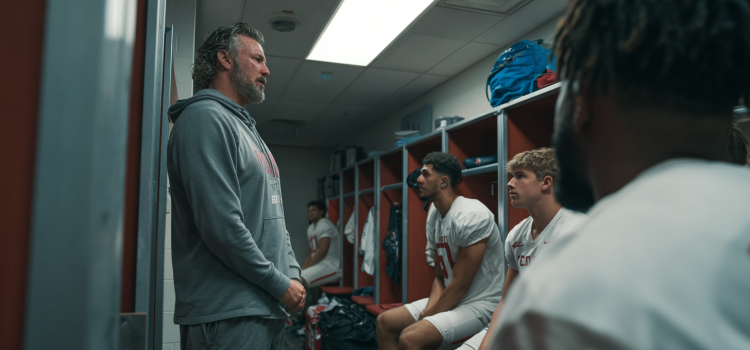
In both sports and business, the key to victory is not raw talent, but the two “big Cs”: character and coaching. In their book You Win in the Locker Room First, Jon Gordon and former NFL coach Mike Smith discuss the unseen work of building trust, commitment, and shared purpose that lays the groundwork for future triumphs.
This overview categorizes Gordon and Smith’s principles for success under those two big Cs. We’ll discuss why team members must be fully dedicated to each other and the team, and we’ll explain how your coaching methods can help that group of dedicated people reach their full potential. Read more in our overview.
Overview of You Win in the Locker Room First
In their book You Win in the Locker Room First, Jon Gordon and former NFL coach Mike Smith discuss how Smith transformed the struggling Atlanta Falcons football franchise by focusing on the team’s culture and unity before even thinking about victory on the gridiron. This overview will teach you Smith’s foundations of success—culture, caring, commitment, consistency, connection, communication, and contagious energy—along with the book’s core message that while talent might get you into the game, it’s the unseen work of building trust, commitment, and shared purpose that ultimately determines whether your team wins or loses.
Gordon is a best-selling author and consultant who has worked with numerous Fortune 500 companies, professional sports teams, and organizations to develop winning cultures and leadership strategies. Meanwhile, Smith served as head coach of the Atlanta Falcons from 2008 to 2014, during which time he took the Falcons from being one of the worst teams in the league to a consistent playoff contender. Gordon’s broad expertise in leadership principles, combined with Smith’s hands-on experience in the high-pressure, results-driven environment of professional football, gives them a unique set of qualifications to discuss how culture and teamwork drive performance.
Character: Help Your Team Be Better
There’s a common misconception that the most successful people are those born with natural talent. However, Gordon and Smith argue that while talent might provide short-term advantages, character determines long-term success. Therefore, you have a responsibility to develop character in those you lead: to help them grow both as members of your team and as people who will positively impact the world beyond your organization.
In this section, we’ll discuss four key elements of character development in a team setting: culture, connection, commitment, and contagious energy.
Character Starts With Culture
Gordon and Smith argue that building a successful team—whether in sports or business—begins with building the right kind of culture, because you need everyone in your organization to think and act in alignment with each other. Your culture encapsulates the shared purpose, attitude, values, and practices that define and guide your team.
To create a winning culture, you must work both from the top down and the bottom up. You need to convince the organization’s owners and executives to buy into your vision, which means having consistent conversations with leadership about shared values and expectations. At the same time, you have to build unity at the team level by evaluating members based on their character and attitude (in other words, their respect for the team culture), not just their technical skills.
The authors add that strategy and tactics are secondary to culture in both urgency and importance. In professional sports, where games are often decided by tiny margins in skill or tactics, teams constantly seek competitive advantages through new ideas and practices. However, culture is the foundation that determines how well your team can implement new methods and repeat past successes. The same holds true in the business world: A positive culture that keeps employees engaged will help your company more than any new tool or trendy practice.
This is not to suggest that strategy and tactics aren’t important—just that improved methods won’t produce the results you hope for unless you’ve already got a strong organizational culture to support those methods.
Personal Connections Create Team Character
A crucial part of building character is learning to trust and value one’s team members as well as oneself. That’s why strong connections transform a group of individuals into one cohesive unit with extraordinary potential. Gordon and Smith say this shift from individual focus to collective achievement is how sports teams beat opponents who are more skilled on an individual basis, but lack unity.
To effectively build connections in the technology-saturated modern world, create opportunities for authentic, face-to-face human interactions. Such opportunities include structured team-building exercises where members share personal stories, challenges, and dreams. However, you should also encourage informal gatherings outside the workplace so team members can get to know each other as human beings, rather than just as colleagues.
Gordon and Smith add that it takes continuous effort to maintain connections—don’t assume that relationships will endure forever once they’re established. Furthermore, the dynamics of any team constantly change as people come and go, which means team members must keep working to adapt to those changes and integrate any new arrivals. Therefore, it’s important to make team-building and social activities a regular part of your operations, not just a short-term project.
Inspire Commitment By Showing Commitment
An important part of a team player’s character is dedication to the team’s success, not just their own. For that reason, Gordon and Smith highlight commitment: the willingness to do everything in your power to help the team, even at personal cost.
Now let’s examine two key elements of commitment: service and sacrifice.
Model Commitment Through Acts of Service
The authors say you can foster commitment among your team members by demonstrating your own commitment to them. Take the time to understand people’s individual goals and challenges, then help them overcome those obstacles and reach their full potential. This is a difficult and sometimes exasperating process, which is why it requires devotion to the team—if you’re only thinking about your own success, you’ll quickly become frustrated and give up.
The best way to show your commitment is through acts of service. For example, such acts include staying late to help someone master a skill or process, advocating for your team members’ interests and well-being, or simply being present during difficult times. Consistently performing small acts like these will show your commitment much more effectively than occasional grand gestures, which may come off as forced or fake.
Prove Your Commitment Through Personal Sacrifice
Gordon and Smith also write that the ultimate test of commitment is sacrifice, which means putting your team’s needs ahead of your own interests. Again, consistency is key: When your team sees you consistently make sacrifices for their benefit, they develop the deep loyalty and trust that enables extraordinary teamwork.
For example, sacrifices might include turning down opportunities that would benefit you personally but harm the team, taking public responsibility for failures (including when those failures weren’t entirely your fault), and investing in team members’ development even if it means they might eventually leave for better opportunities.
Character Is Contagious
Your emotional state and energy spread to everyone around you, affecting your team in profound ways. In other words, it’s contagious. As a leader, you must choose to be a source of contagious positive energy for your team.
Let’s examine two key strategies Gordon and Smith provide to energize your team: Give them an inspirational mission to rally behind, and proactively root out negativity.
Inspire Your Team With a Clear Vision
The authors say one of the most effective ways to spread positive energy is through a compelling vision or mission—something that goes beyond individual success and unites your team around a common cause. Your vision should be simple, clear, and bold enough to serve as a rallying cry: Some examples are supporting the community and honoring important traditions.
However, avoid generic goals like winning championships. The authors say such obvious goals aren’t effective because your team members are already thinking about them all the time. Continually reminding your team of what they already know does nothing to inspire or energize them.
Don’t Let Negativity Take Root
Being contagious in a positive way also means actively protecting your culture from negativity. To that end, Gordon and Smith suggest that you establish clear expectations about attitude and energy. People who are unwilling or unable to meet those expectations must not be allowed to remain on your team, since they’ll spread their pessimism and drain enthusiasm from their teammates. No amount of individual talent can make up for how much a bad attitude will hinder the team’s performance.
For example, you might implement a “no blame” rule: Make it clear that team members blaming each other for a loss or mistake is unacceptable. Instead, emphasize that defeats and setbacks are opportunities for the entire team to learn and grow.
Coaching: Help Your Team Do Better
Character provides the foundation for future success, which is why it should be your first concern. However, Gordon and Smith say that your team will ultimately win or lose depending on your ability to coach: to develop your team members’ skills through training, then make the right decisions on the field (or in the workplace, as the case might be).
In this section we’ll discuss the authors’ three remaining principles of success, which characterize effective coaching: consistency, communication, and care.
Be Consistent, and Demand Consistency
Your consistency as a leader impacts the trust your team has in you, and it’s impossible to coach a team that doesn’t trust you. This is why Gordon and Smith emphasize consistency: You must stick to your principles, ideals, and methods no matter what difficulties you or your team face.
It’s hardest to maintain consistency during difficult times, like when you or your team face failures and criticisms. At such times it can be tempting to abandon your current approach and try something dramatically different. However, the authors argue that this is precisely when consistency matters most: Your team needs to know what to expect from you, and trust that you’ll stick to your principles through adversity.
The authors add that consistency isn’t just for leaders—every team member must show consistent effort and attitude, especially in the face of adversity. The best performers at any level are unwaveringly dedicated to their routines: They always follow established processes, maintain high standards of conduct and performance, and constantly seek ways to improve themselves.
Conversely, if some people are unreliable, it creates an environment of uncertainty that erodes trust and cohesion among the entire team. Therefore, team members who can’t or won’t put forth consistent effort must be let go.
Coaching Is Communicating
Gordon and Smith say that a crucial part of coaching is communication: talking openly and often with your team members, both as individuals and as a group. Try to engage with people at every level of your organization as often as possible, in as many different places as possible (not just in your office). This means putting in appearances in break rooms, hallways, and other informal settings. If you make yourself visible and accessible in this way, you’ll break down hierarchical barriers—team members will start to see you as a person, not just as their boss.
The authors add that during your interactions, listening is often more important than talking. Effective leadership requires you to ask thoughtful questions, and genuinely listen to the responses. When you take the time to listen to everyone’s perspective—from leadership to support staff—you gain valuable insights that allow you to make better decisions as a leader. As an added benefit, it demonstrates that you respect and value everyone on your team regardless of their position.
Genuinely Care About Your Team Members
Finally, Gordon and Smith say that you can only build a winning team if you genuinely care for the people you lead: You have to see your team members as real people, not just tools to help you achieve your goals. When you truly care about each team member’s well-being and success, you foster an environment where people feel valued and appreciated—and they’ll reciprocate by putting forth their best efforts.
You can demonstrate care through actions that show your team members they matter as individuals. For example, a leader who cares will remember important events in their team members’ lives like birthdays and anniversaries, check in when they’re facing difficulties, and celebrate both their professional and personal successes. Small gestures like these build upon each other to create powerful bonds that strengthen your entire team.
The authors add that the best leaders care enough to help each individual reach their full potential, which bolsters the team as a whole. To do so, you have to balance accountability and supportiveness. As a coach, this means you set high expectations for your team members and push them outside of their comfort zones, but also make sure they have the tools to meet those challenges.
For example, suppose you’re the coach of a basketball team, and you notice that your point guard hesitates to take crucial shots during close games. You might approach that player and set a high expectation like “I want you to take the big shots when the game is on the line.” To make sure the point guard is prepared to meet your expectations, you’d then put them through high-pressure practice scenarios and teach them some mental preparation techniques to ensure they won’t freeze up when the pressure’s on.
FAQ
1. What is the main idea of You Win in the Locker Room First?
Jon Gordon and Mike Smith argue that success starts with building trust, commitment, and shared purpose within a team—long before the actual competition begins.
2. What are the seven foundations of success according to the authors?
You Win in the Locker Room First highlights culture, caring, commitment, consistency, connection, communication, and contagious energy as the essential pillars of a winning team.
3. How do Gordon and Smith define “culture”?
They define culture as the shared purpose, attitude, values, and practices that align everyone in the organization and guide their actions.
4. Why is culture more important than strategy or tactics?
The authors explain that culture determines how well a team can implement new methods and sustain success. Without it, even the best strategies will fail.
5. How can leaders build stronger team connections?
By fostering authentic, face-to-face interactions, leaders help team members trust and value one another.
6. How can leaders spread positive energy within their teams?
Leaders can energize their teams by providing a clear, inspiring vision and by actively preventing negativity from taking root in the culture.
7. What do Gordon and Smith say about communication in coaching?
Effective coaching depends on open, frequent communication and genuine listening, which help leaders gain insight, build trust, and make better decisions.
8. How does caring contribute to a winning team culture?
When leaders genuinely care about their team members as people—celebrating their successes, supporting them in hardships, and pushing them to grow—they inspire dedication and unity across the team.






